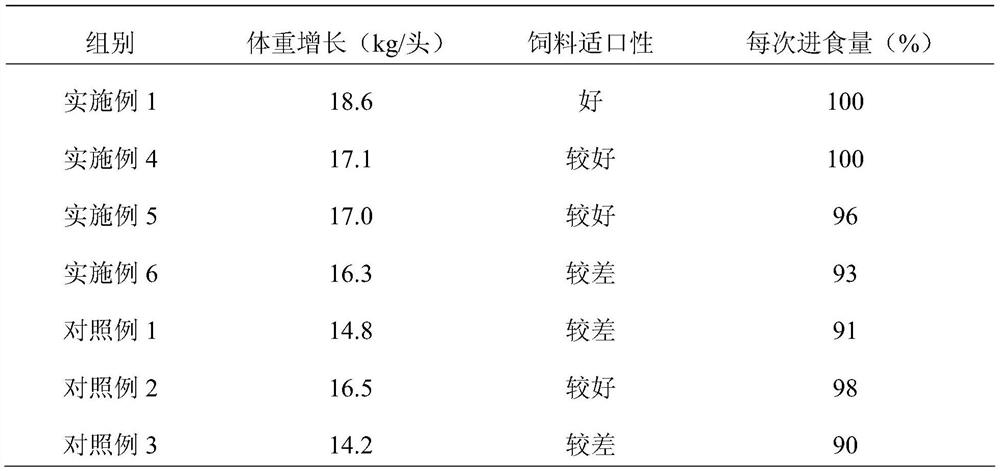Method for preparing cattle and sheep feed from mulberry stems
A mulberry rod and feed technology, applied in animal feed, animal feed, application and other directions, can solve the problems of sour taste, waste of resources, difficult to swallow, etc., and achieve the effect of improving taste, improving palatability and enriching nutrition.
- Summary
- Abstract
- Description
- Claims
- Application Information
AI Technical Summary
Problems solved by technology
Method used
Image
Examples
Embodiment 1
[0033] A method for preparing feed for cattle and sheep by using mulberry stalks, comprising the steps of:
[0034] S1. Preparation of biological fermentation broth: by weight, weigh 1.2 parts of cellulase, 0.7 parts of pectinase, 0.3 part of ligninase, 0.2 part of phytase, 1.5 parts of Lactobacillus plantarum, and 1 part of Clostridium butyricum 15 parts of rice wine, 40 parts of rice water, and 8 parts of wood vinegar; mix the above components evenly to obtain a biological fermentation liquid for future use.
[0035] S2. Treatment of mulberry stalks: chop mulberry stalks, the length of which is 0.5-1 cm after chopping mulberry stalks, dehydrate the mulberry stalks to a water content of 45% after chopping them, and soak them in soaking liquid for 10 hours, The soaking solution is prepared by mixing the following raw materials in parts by weight: 7 parts of salt, 3 parts of wood vinegar, and 95 parts of water. After soaking, the mulberry stems are dried to a water content of 3...
Embodiment 2
[0049] A method for preparing feed for cattle and sheep by using mulberry stalks, comprising the steps of:
[0050] S1. Preparation of biological fermentation broth: in parts by weight, weigh 1.0 part of cellulase, 0.5 part of pectinase, 0.1 part of ligninase, 0.1 part of phytase, 1.0 part of Lactobacillus plantarum, Clostridium butyricum 0.5 parts, 10 parts of rice wine, 30 parts of rice water, 5 parts of wood vinegar; mix the above components to obtain a biological fermentation liquid, and set aside.
[0051] S2. Treatment of mulberry stalks: chop mulberry stalks, the length of which is 0.5-1 cm after chopping mulberry stalks, dehydrate the mulberry stalks to a water content of 40% after chopping them, and soak them in soaking liquid for 15 hours, The soaking liquid is prepared by mixing the following raw materials in parts by weight: 5 parts of salt, 1 part of wood vinegar, and 90 parts of water. After soaking, the mulberry stems are dried to a water content of 30% for late...
Embodiment 3
[0065] A method for preparing feed for cattle and sheep by using mulberry stalks, comprising the steps of:
[0066] S1. Preparation of biological fermentation broth: by weight, weigh 1.5 parts of cellulase, 1.0 part of pectinase, 0.5 part of ligninase, 0.5 part of phytase, 2.5 parts of Lactobacillus plantarum, Clostridium butyricum 1.5 parts, 20 parts of rice wine, 50 parts of rice water, and 10 parts of wood vinegar; mix the above components to obtain a biological fermentation liquid, which is set aside.
[0067] S2. Treatment of mulberry stalks: chop mulberry stalks, the length of which is 0.5-1 cm after chopping mulberry stalks, dehydrate the mulberry stalks until the water content is 50%, and soak them in soaking liquid for 5 hours. The soaking solution is prepared by mixing the following raw materials in parts by weight: 10 parts of salt, 5 parts of wood vinegar, and 100 parts of water. After soaking, the mulberry stems are dried to a water content of 40% for later use. ...
PUM
| Property | Measurement | Unit |
|---|---|---|
| Length | aaaaa | aaaaa |
| Granularity | aaaaa | aaaaa |
| Length | aaaaa | aaaaa |
Abstract
Description
Claims
Application Information
 Login to View More
Login to View More - R&D
- Intellectual Property
- Life Sciences
- Materials
- Tech Scout
- Unparalleled Data Quality
- Higher Quality Content
- 60% Fewer Hallucinations
Browse by: Latest US Patents, China's latest patents, Technical Efficacy Thesaurus, Application Domain, Technology Topic, Popular Technical Reports.
© 2025 PatSnap. All rights reserved.Legal|Privacy policy|Modern Slavery Act Transparency Statement|Sitemap|About US| Contact US: help@patsnap.com

